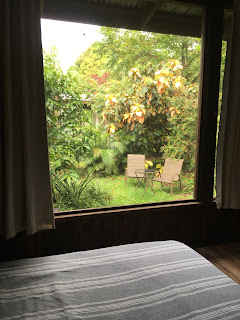Thursday, August 27, 2020
Ashes Twice on the Silver Fork Trail
Friday, August 14, 2020
The Difference a House Makes
 The house was hippy-adorable: a porch and a one-room interior with a low double bed at one end, a kitchen at the other, and an outdoor shower and bathtub. It had a tin roof, like all houses in Hilo, but it also had tin walls, a sliding screen for a front door, and, in a lot of places, screens instead of windows. The unpainted wood of the house made it look as natural as its surroundings. The bright colors of everything else—painted chair, shower curtain—took a cue from the colorful fish and flowers of Hawaii. The house nestled so tightly among the tropical vegetation it was like another natural element.
The house was hippy-adorable: a porch and a one-room interior with a low double bed at one end, a kitchen at the other, and an outdoor shower and bathtub. It had a tin roof, like all houses in Hilo, but it also had tin walls, a sliding screen for a front door, and, in a lot of places, screens instead of windows. The unpainted wood of the house made it look as natural as its surroundings. The bright colors of everything else—painted chair, shower curtain—took a cue from the colorful fish and flowers of Hawaii. The house nestled so tightly among the tropical vegetation it was like another natural element.Itch, Itch, Scratch, Poor Wretch
What is an itch?
A sparkler under the skin, flaring upward, stabbing the underside of the skin with tiny sharp pinpricks of fire. A demand for scratch.
Why does it occur?
Perhaps because you have an allergy to fragrances in substances like soaps and detergents and although you knew that commercial hand sanitizer must have fragrance in it (of course, because otherwise it would smell like alcohol; why did't you think about that?), you accepted your friend's offer that you use hers after you touched her phone because, alter all, she was doing you a kindness and you wouldn't want to deny her that opportunity, would you?
Where does it occur?
On various parts of the body, now here, now there: arms, hands, wrists, between the fingers, on the palm, shins, ankles, knees, tops of the feet, back of the neck, scalp, chin, forehead, ear lobes, under the breasts, around the navel, in the pubic area, tops of the thighs (front and back)—just about everywhere except the bottoms of the feet and, so far, thank goodness, the unreachable back.
What can you do about it
(1) You can scratch and scratch and scratch until the flesh burns and you lie back exhausted and let the burn take the place of the itch till in a few minutes the itch demands scratch again. Be careful not to tear the skin in your frenzy to get at the fire.
(2) You can try to smother the fire by rubbing the itch hard, but it will always smolder under the rubbing motion.
(3) Fire retardant in the form of an itch-relief medication will put it out for, maybe, ten minutes. Then it comes back as though never treated.
(4) Cold water will put out the fire most effectively and for the longest time. Keep a bathtub full of cold water for immersion when the fire comes into the legs or the stomach. If you can stand the cold, you can even immerse yourself to the back of the neck. Say good-bye to hot showers and to a solid night's sleep. Keep a pot off ice water by your bedside for plunging your arms into when the itch demands it during the night. The fire will always come back, but for a while there will be relief.
(5) Do nothing. Don't scratch. Ha. Just try it.
Will it ever stop?
Yes. It eventually works itself out of the system, and there will be no more fire, no more itch. In the meantime and forever after, never, never, never put your skin in contact with any substance that has fragrance added to it. Read all labels. Essential oils are all right, but if the label says, "Fragrance" or "Parfum [perfume]" in the list of ingredients, DO NOT USE. Remember what an itch is, and DO NOT USE.








